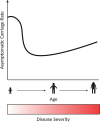From Nursery to Nursing Home: Emerging Concepts in Clostridioides difficile Pathogenesis
- PMID: 32122939
- PMCID: PMC7309631
- DOI: 10.1128/IAI.00934-19
From Nursery to Nursing Home: Emerging Concepts in Clostridioides difficile Pathogenesis
Abstract
Clostridioides difficile is a Gram-positive, spore-forming, anaerobic bacterium that infects the human gastrointestinal tract, causing a wide range of disorders that vary in severity from mild diarrhea to toxic megacolon and/or death. Over the past decade, incidence, severity, and costs associated with C. difficile infection (CDI) have increased dramatically in both the pediatric and adult populations. The factors driving this rapidly evolving epidemiology remain largely unknown but are likely due in part to previously unappreciated host, microbiota, and environmental factors. In this review, we will cover the risks and challenges of CDI in adult and pediatric populations and examine asymptomatic colonization in infants. We will also discuss the emerging role of diet, pharmaceutical drugs, and pathogen-microbiota interactions in C. difficile pathogenesis, as well as the impact of host-microbiota interactions in the manifestation of C. difficile-associated disease. Finally, we highlight new areas of research and novel strategies that may shed light on this complex infection and provide insights into the future of microbiota-based therapeutics for CDI.
Keywords: Clostridium difficile; infectious disease; microbiota.
Copyright © 2020 American Society for Microbiology.
Figures


References
Publication types
MeSH terms
Grants and funding
LinkOut - more resources
Full Text Sources
Medical
Miscellaneous

